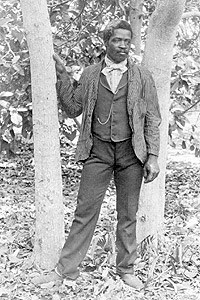|
A Remarkable Story - For nearly a century the Jones family thrived on Porgy Key and other islands at the southern end of the park. That an initial $300 investment in land could turn into a total resale of nearly $1.5 million is all the more astonishing when one recognizes that most African-Americans living in the south in the early 20th-century were barely able to eke out a living, much less become millionaires. October 13 is designated as Lancelot Jones Day in Florida. The Jones Family Historic District is listed on the National Register of Historic Places. It includes the former home and farm of Israel Lafayette Jones and his family on Porgy and Totten Keys. The following narrative is based on the Israel Lafayette Jones Site study by Carolyn Finney. 
Photo by Ralph Middleton Munroe The Early Years (1858-1898) - Israel Lafayette Jones was born in 1858 in Raleigh, North Carolina. His father was Arter Jones, a farm laborer from North Carolina. Israel had a younger brother named Samuel, born in 1861. By 1880, Arter was married again to Caroline Jones, who was just one year younger than Israel. Israel's biological mother remains a mystery. While slave schedules cannot affirm whether or not Jones or his parents were born into slavery, in North Carolina around 1830, only one percent of the black population were freemen. By 1860 there were less than 40,000 freed blacks. In addition, in 1850, when his father would have been 23 years of age, seventy-five percent of all slaves were farm laborers.
When he was twenty-two years old, Jones worked as a farm laborer himself. During the 1880s he moved to Wilmington, North Carolina where he was a stevedore and handled small boats. As a major seaport, Wilmington attracted many African-American maritime laborers who came there in search of work on or by the sea. They made up 60% of the total population in North Carolina’s larger seaports. While it is difficult to estimate the percentage of African-Americans working full-time in a maritime trade, it is safe to say that most slaves and freemen who lived on the coast worked on the water at least occasionally. For black men, maritime occupations included laboring as sailors, fishermen, boatmen and pilots. Israel Jones headed to Florida in 1892 in search of work. Before settling in Key Biscayne, he tried his hand at growing oranges in Orlando, but was unsuccessful due to a freeze. After a short stint in Tampa, he made his way further south. In the mid-nineteenth century, South Florida was largely wilderness where black families often lived in isolation from each other on the groves and farms of white owners. For many blacks, job opportunities came in the form of digging for coontie (a wild cycad indigenous to the region and used for making starch), clearing land, and working in the lumber industry. Walter S. Davies, a well-to-do white landowner, had significant property holdings on Cape Florida and needed a caretaker for his property. He dispatched his agent Ralph Monroe (boat designer and commodore of Biscayne Bay Yacht Club in Coconut Grove) to find an appropriate employee. He hired Israel Jones, who became the caretaker on the Davis Grant and several other properties, including those belonging to Dr. John Clayton Gifford and Commodore Monroe. In 1893, Jones also went to work as a foreman for a pineapple farm belonging to Frank T. Budge. During his tenure as caretaker and foreman, Jones developed skills in growing lime and pineapple trees. Built in 1882, the Peacock Inn in Coconut Grove became a magnet for black pioneers who were newly arrived to the South Florida region and seeking employment. Owned and constructed by Charles Peacock, the inn hired many black Bahamians new to the area. Though not Bahamian, Israel Jones procured a job as a handyman and met his future wife, Mozelle Albury at the inn. They married in 1895.Born in December 1861 in Harbor Island, Bahamas, her family migrated to Key West in 1871.This was not unusual; during the 1880’s many Bahamians arrived to the South Florida region to work as farm laborers or at the inn. Economic exploitation and racial discrimination convinced many Bahamians that they’d be better off in the South Florida area, particularly in Biscayne Bay and the Florida Keys. Shortly after their marriage in 1895, Israel Lafayette Jones and his wife Mozelle had their first son King Arthur Lafayette Jones, born in March of 1897. Their second son, Sir Lancelot Garfield Jones was born almost a year and a half later in October of 1898. Both sons are believed to be the first black Americans born on Key Biscayne. Lancelot was delivered by a midwife and Dr. Henry Jackson, whom Jackson Memorial Hospital is named after. |
Last updated: June 19, 2025
